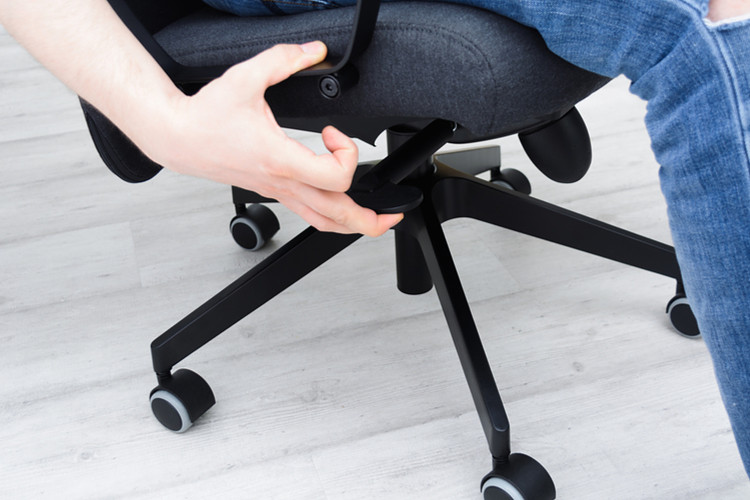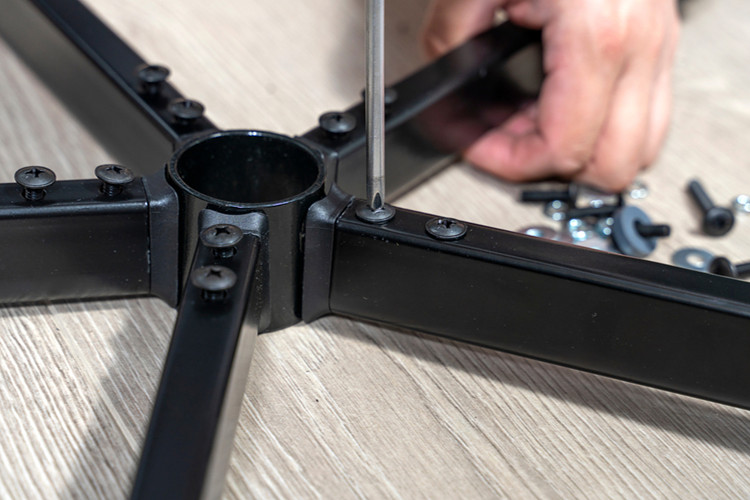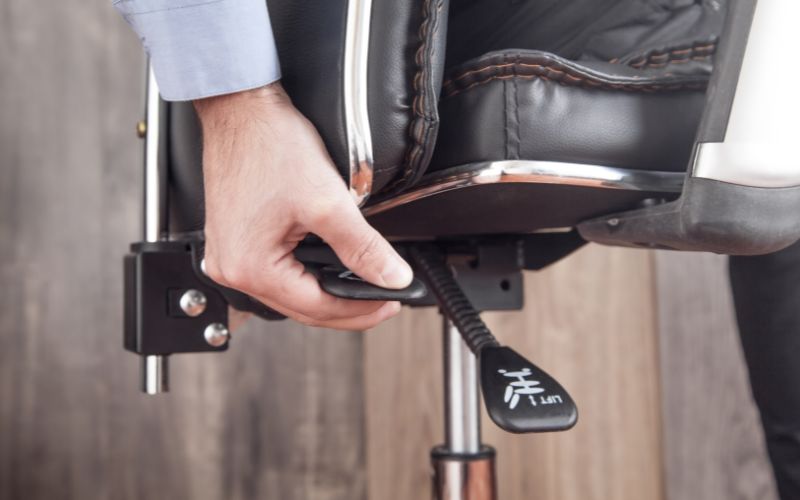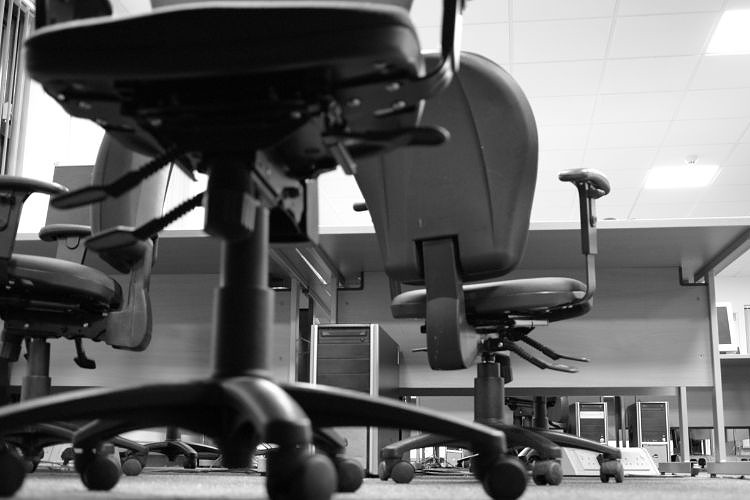An office chair is not just a seat. It’s an environment. This is why you find it annoying when any part of your chair stops working as it should.
Usually, the chair cylinder is the culprit that deserts from its duties. In other words, the cylinder is the proverbial weakest link.
Chair cylinders can break down in multiple ways. For instance, they can get stuck, broken, or touch the floor. The cause is usually incorrect use, poor build materials, or just the normal end of your chair’s lifespan.
In this article, we focus on why chair cylinders touch the floor and what you can do to fix or prevent it.
If, by any chance, you are looking for how to repair a stuck chair cylinder, check out this article.
So without further ado, let’s look at the likely reasons why your chair cylinder is touching the floor.
Table of Contents
- Reason 1: The chair base is not made of good quality materials
- Reason 2: There’s normal wear and tear
- Reason 3: The chair base is broken
- Reason 4: The chair base and cylinder connection is loose
- Reason 5: The chair base is bent
- Reason 6: You need an office chair or a chair base with a higher weight specification
- How to Fix an Office Chair Cylinder that Touches the Floor
- How Do I Prevent the Cylinder of My Office Chair from Touching the Floor?
Reason 1: The chair base is not made of good quality materials

Simple as that. Budget constraints sometimes lead us into buying cheap office chairs when we know that they are likely made of poor materials that are not durable. This gamble, though tempting, often ends in early breakdowns that you could have avoided if you had bought a better-quality chair.
In addition, poor-quality chair bases have a habit of suddenly giving in and sending you sprawling to the floor. As a result, you might end up buying a new chair or base, plus a possibly expensive trip to the doctor.
Reason 2: There’s normal wear and tear
There’s an African proverb that says, “what doesn’t end is a miracle.” I know it’s a bad translation, but I hope you get the point. It means all things must eventually end, including your premium or not-so-premium chair base.
Of course, the quality of your chair base and the manner in which you use it play a huge role in determining your chair base’s lifespan.
At the end of this article, you will find best practices and things to avoid if you want a long-lived office chair and chair base.
Reason 3: The chair base is broken

If your chair cylinder is dragging through your carpet or floor, chances are your chair base is broken or cracked. Sometimes the crack could only be in one of your chair base’s arms or wheels. Other times, there might be cracks in multiple places.
If this is the case for your chair base, buying a good replacement chair base is the safest solution. Attempting any stopgap repairs might end in undesirable and avoidable injuries or accidents.
Reason 4: The chair base and cylinder connection is loose
This is often the common reason why a chair cylinder touches the floor. The slightly conical hole where your cylinder slides in might get bigger after some use. As a result, your cylinder has to sink further to get a solid grip on your chair base.
The leading causes for widening the connection point between your cylinder and chair base is flopping down in your chair or a chair base made of materials that are easy to deform.

Reason 5: The chair base is bent
If none of the above reasons relate to your situation, your chair base might somehow be bent. As a result, the chair base’s clearance for the cylinder is no longer there.
Common causes of bent chair bases are throwing yourself into your chair, poor quality chair bases, or insufficient load-bearing capacity.
The solutions for a bent chair base include:
- Straightening with a rubber mallet or equivalent method
- Replacing the wheels with bigger or taller ones
- Replacing the current chair base with a stronger one that won’t bend
Reason 6: You need an office chair or a chair base with a higher weight specification

If your chair is relatively new and none of the above reasons check your box, you might have to check whether your chair or chair base’s load-bearing capacity can support your weight.
If you are over the stated weight limit, you might have to either replace the chair base or the chair cylinder. Alternatively, you can buy a more suitable chair.
To find the load-bearing specifications, you will have to google it, look for any tags or stickers on your chair, or check the papers that came with your chair.
How to Fix an Office Chair Cylinder that Touches the Floor
Since we covered the likely causes of your cylinder problem, it’s time to look at the solutions.
Now, if you are feeling lazy and don’t want to tinker around with repairing your current components, the easy one-size-fits-all solution would be to buy new parts and replace the problematic cylinder, chair base, or both.

Here’s the step-by-step procedure on how to replace a chair cylinder or chair base:
- Get a rubber mallet, screwdriver, and a pipe wrench. If you don’t have a rubber mallet, you can try using a regular hammer with a folded towel.
- Cover your work area with newspapers, a rug, a cloth, or a similar option.
- Flip your office chair into an upside-down position.
- Spray some lubricant (e.g., WD40) into the connections between your chair base and the bottom of your seat. Wait a few minutes.
- Depending on the difficulty, tap on the top of the chair base to detach it from the cylinder.
- If you are only replacing the chair base, you can attach a matching chair base to your chair cylinder.
- To remove the cylinder, carefully grip it with your pipe wrench near the top and twist it from the mechanism. Alternatively, you can unscrew the top mechanism plus the cylinder from the chair. And then detach your cylinder by hitting the mechanism with your mallet.
- To install the replacement(s) after attaching the topmost mechanism, place the components into the corresponding grooves.
- Carefully flip the assembled chair into an upright position and sit on it. Your seating weight should help the components fasten together.
You can also check out this youtube video for a visual demonstration.
On the other hand, if you’re comfortable with a bit of tinkering and if your components are not broken, you can look at the following cheaper alternatives.
- If your chair base is bent: You can straighten your chair base using calculated brute force or hammering. Take care not to break anything. You can also add taller wheels to give your hanging cylinder extra clearance.
- If the chair base and cylinder groove is loose: Add extra padding using suitable material, e.g., a coke can. Make sure the padding matches the groove without any overlap. Overlaps will cause wobbling due to an uneven grip. For a detailed guide on making a coke can shim or pad, check out this article from Colinhelps.com.
- If there are any loose hose clamps or bolts: This can be solved easily with a little tightening.
After finishing the repairs, you can try sitting and spinning in your office chair to check if it’s fixed and everything is in order.
That being said, all the above fixes might be unnecessary if your chair’s warranty is still valid. In fact, any tinkering on your part might void your warranty.
Therefore, if your warranty is still valid, you can try getting in touch with the store that sold you your chair. By doing so, you might get a free replacement or repair. This might be the best option if you are not as handy.
How Do I Prevent the Cylinder of My Office Chair from Touching the Floor?
As the old sayings go, “prevention is better than cure,” and “a stitch in time saves nine.” Indeed, this ancient wisdom holds true in the case of office chairs.

Maintenance and conscious and careful use can avoid many chair problems in the long run.
Here are some practical tips on what to do and what to avoid for the best experience:
- Buy a good quality office chair that has good after-sales services and is also built using durable materials. This will help you avoid a lot of future headaches.
- If your chair base is weak, replace it with a stronger one.
- Avoid throwing yourself into your chair, as the impact can speed up your chair’s deterioration.
- Avoid leaning too much when sitting or sliding around in your chair. This puts uneven stress on your chair and its base. As a result, your chair might unexpectedly give out under you.
- Sit properly in your chair. Avoid sitting at the edge of your seat and leaning to one side too much. Doing so puts too much stress on a few components instead of evenly distributing your weight throughout the chair. In addition, a correct sitting posture does not just protect your chair; it also protects your health.
Hopefully, you have found the answer to your problem in this article. You can also check out our other articles to never be stumped by furniture problems again.
Thanks for reading.

My name is Vance, and I am the owner of To Ergonomics. Our mission is to improve your workflow by helping you create a supportive and welcoming environment. We hope that you’ll find what you’re looking for while you’re here.

